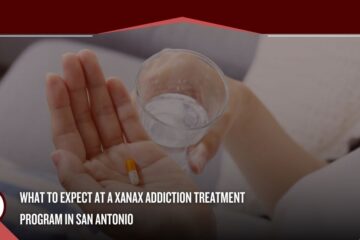Overcoming addiction is a complex process and one that should not be taken lightly. It’s not just about willpower; it requires a comprehensive approach used in addiction treatment. This is why, at Alamo Behavioral Health Center, we advocate for Medication-Assisted Treatment (MAT), a scientifically validated method. By combining FDA-approved medications used in addiction treatment with counseling and behavioral therapies, we offer a holistic solution to substance use disorders.
Our unwavering commitment is to provide unparalleled care for our patients throughout their recovery journey. This begins with a top-tier medical detoxification process, marked by its emphasis on quality, empathy, and a comforting environment. Additionally, we offer a stabilization phase that includes both detoxification and residential services within our welcoming and inclusive inpatient rehab San Antonio facility. Our team of seasoned professionals is dedicated to helping individuals reclaim their lives and rediscover their inherent purpose.
Alamo Behavioral Health explores the diverse range of medications used in addiction treatment. We will discuss their benefits, potential side effects, and how they work, aiming to empower both individuals and their loved ones with knowledge about the process of drug detox in San Antonio. With this understanding, they can make well-informed decisions about their treatment.
Principles and Benefits of Medication-Assisted Treatment
Medication-Assisted Treatment (MAT) is a comprehensive approach to managing substance use disorders (SUDs). It combines the integration of counseling and behavioral therapies in conjunction with FDA-approved drugs. It treats the whole individual, addressing both the physical and psychological aspects of addiction. Our medical detox in Texas encompasses the principles and definition of this method.
The benefits of MAT are numerous. It improves patient survival rates, increases retention in treatment, decreases illicit opiate use and other criminal activities among people with substance use disorders, and improves patients’ ability to gain and maintain employment.
MAT is not a one-size-fits-all approach. The remedies applied in MAT vary depending on the type of substance use disorder. For opioid use disorders, medications such as methadone, buprenorphine, and naltrexone are commonly utilized. These prescriptions work by blocking the euphoric effects of opioids, relieving cravings, and normalizing body functions.
The difference between MAT and MOUD (Medication for Opioid Use Disorder) lies in their scope. While MAT is a broad term that encompasses the application of pharmaceuticals to treat various substance use disorders, MOUD specifically refers to the use of drugs to manage opioid use disorders.
Medications Used in Addiction Treatment and Setting
When it comes to Medication Assisted Treatment in Texas, individuals have access to various treatment options tailored to their specific needs and the severity of their substance use disorder. These include inpatient rehab facilities and residential care programs. The selection of the most suitable setting is determined by careful consideration of the individual’s requirements and the level of support and structure needed to provide their recovery.

An example of MAT is a program that combines the utilization of methadone, a medication that helps suppress withdrawal symptoms and reduce cravings in people with opioid use disorders, with regular counseling and participation in a community-based support group.
It is a proven, effective approach to taking care of substance use disorders. Combining drugs with counseling and behavioral therapies, it provides a comprehensive, individualized treatment plan that addresses all aspects of the patient’s health and well-being.
Opioid Addiction Medications
Opioids include drugs such as heroin, fentanyl and prescription painkillers like oxycodone and hydrocodone. These are highly addictive and can lead to physical dependence and withdrawal symptoms when stopped.
Opioid addiction is a very serious issue that requires comprehensive treatment. This type of treatment is also necessary for patients who suffer from underlying mental health issues as well as addiction. They can undergo a dual diagnosis treatment. At our dual diagnosis treatment center Texas patients are informed about everything that’s happening. We use a variety of medications to help individuals overcome their bad habits. Each with its unique mechanism of action and benefits, these medications include:
- Methadone
- Buprenorphine
- Naltrexone
Methadone
Methadone, a long-acting opioid agonist, works by binding to the same opioid receptors in the brain as other opioids like heroin and prescription painkillers. By doing so, it helps to reduce cravings and withdrawal symptoms, making it an effective option for fentanyl detox in Texas. Methadone is used primarily for opioid dependence and is administered under a healthcare professional’s supervision due to its potential for misuse.
Buprenorphine
Buprenorphine, a partial opioid agonist, also binds to the brain’s opioid receptors but with less intensity, reducing the euphoric effects. It is applied for opioid dependence and is often combined with naloxone to prevent misuse. Buprenorphine is effective in managing withdrawal symptoms and cravings, making it a viable option for heroin detox in Texas. Despite its benefits, it’s important to remember that no medication is inherently “bad” or “good.” Its effectiveness and safety depend on how it’s used and the individual’s specific needs.
Naltrexone
Naltrexone, an opioid antagonist, works differently. It blocks opioid receptors in the brain, preventing the euphoric and pain-relieving effects of opioids. This makes it useful for preventing relapse after detox, including meth detox in Texas. Although there are no known drugs to be taken when dealing with methamphetamine addiction, studies show that a combination of injectable naltrexone and oral bupropion was very safe and effective. Naltrexone is typically adopted once the individual has fully detoxed from opioids.

Side effects and risks of opioid addiction medications
In terms of safety, both buprenorphine and methadone can be safe when used as directed under medical supervision. However, like all drugs, they can have side effects and risks, which should be discussed with a healthcare provider. Some of the side effects include:
- Nausea
- Constipation
- Headache
- Dizziness
- Drowsiness
- Dry mouth
- Sweating
- Changes in sexual desire
Alcohol Addiction Medications
This type of addiction is a complex condition that often requires a multi-faceted approach to healing. Alcohol detox in San Antonio offers struggling individuals various medications that can aid in their recovery journey. These include Disulfiram, Acamprosate, and Naltrexone.
In terms of effectiveness, all three pharmaceuticals can be beneficial in dealing with alcoholism. The “best” drug will depend on the individual’s specific needs, medical history, and the severity of their addiction. It’s important to discuss these factors with a healthcare provider to determine the most appropriate treatment plan. It is important to remember that medication is just a part of this process, and it should not be the only step forward you take.
Disulfiram
Disulfiram works by producing unpleasant side effects such as nausea and flushing of the skin when alcohol is consumed. This reaction is intended to deter struggling individuals from drinking. It’s important to note that Disulfiram does not reduce the cravings for alcohol, but it can help some people maintain their sobriety by discouraging them from drinking.
Acamprosate
Acamprosate, on the other hand, works by restoring the balance of certain chemicals in the brain that have been altered by alcohol abuse. This can help to reduce cravings and the discomfort of withdrawal symptoms. Furthermore, it is typically applied in people who have already achieved sobriety and are working to maintain it.
Naltrexone
Naltrexone is another medication used in the treatment of alcohol addiction. It works by blocking the euphoric feelings of intoxication that come with drinking alcohol, helping to reduce the desire to drink. Naltrexone is safe for most people, but it can have side effects, and it may not be suitable for individuals with certain liver conditions. The duration varies depending on the individual’s needs and response to the drugs.

Nicotine Addiction Medications
Nicotine addiction is a widespread issue that can be challenging to overcome. However, it is not impossible to do, using Nicotine Replacement Therapy (NRT) or medications known as Bupropion and Varenicline.
Nicotine Replacement Therapy (NRT)
Nicotine Replacement Therapy (NRT) is a treatment that helps patients quit smoking by providing a controlled amount of nicotine to ease withdrawal symptoms. Examples of NRT include nicotine patches, gum, lozenges, inhalers, and nasal spray. The goal of NRT is to reduce the body’s dependence on nicotine gradually. The most successful NRT varies among individuals, but all forms are effective when used correctly.
All these medications can be effective in treating nicotine addiction, but they should be used as part of a comprehensive quit plan that includes behavioral support. The safety and age limit for these can also vary. Long-term usage of NRT is generally safe, and some people may need to apply NRT for longer periods to quit smoking successfully. However, the goal should always be to end the dependence on nicotine.
Bupropion
Bupropion is an antidepressant that has helped people quit smoking by reducing cravings and withdrawal symptoms. It’s important to note that while nicotine isn’t an antidepressant, some people may find that smoking has a temporary effect on mood, which can be part of the addiction.
Varenicline
Varenicline works by blocking nicotine receptors in the brain, reducing the pleasure of smoking and easing withdrawal symptoms. Some studies suggest that Varenicline may be more effective than NRT in helping people quit smoking, but the best treatment depends on the patient’s specific needs and medical history.

Other Medications Used in Addiction Treatment
In the realm of addiction treatment, various drugs manage co-occurring disorders such as anxiety and depression. Two such classes are Benzodiazepines and Antidepressants and Antianxiety medications.
It’s important to note that while these can be effective in treating co-occurring disorders, they should be applied as part of a medical care plan that includes different types of therapies and support for medication dependence and anxiety.
Benzodiazepines
Benzodiazepines, often referred to as “benzos,” are a class of drugs that primarily treat anxiety, but they can also work in the management of alcohol withdrawal symptoms. Common benzodiazepines include Xanax (alprazolam) and Valium (diazepam). These work by slowing down the central nervous system and inducing a calming effect. Although giving this effect can be quite beneficial for those struggling with addiction, it is important to understand that Benzodiazepines are also highly addictive.
Antidepressants and Antianxiety medications
Antidepressants and Antianxiety medications, on the other hand, are used to treat a variety of conditions, including depression, anxiety disorders, and sometimes, in the case of certain antidepressants, nicotine cravings. Examples of these drugs include selective serotonin reuptake inhibitors (SSRIs) like Prozac (fluoxetine) and Zoloft (sertraline), and serotonin and norepinephrine reuptake inhibitors (SNRIs) like Effexor (venlafaxine).
Individualized Treatment and Professional Guidance
Here we will uncover how individualized treatment and professional guidance interlock together to form a strong base for your recovery. Remember, we go one step at a time!
Individualized treatment
Individualized treatment refers to a therapeutic approach that meets the unique needs of each patient. This approach recognizes that each person’s journey to recovery is different, and therefore, the plan must address their specific challenges, strengths, and goals. An individualized treatment plan might include a combination of therapies such as medication-assisted care, counseling, and behavioral therapies.
An example of individual therapy could be one-on-one sessions with a therapist where those in need can explore their feelings, beliefs, and behaviors, work through challenging memories, identify aspects of their lives that they would like to change and set personal goals. Of course, other options are still available, like group or family therapy sessions, that can be beneficial for their sociological factors.
Professional guidance
Professional guidance, on the other hand, refers to the support and advice provided by trained professionals such as therapists, counselors, and doctors. This guidance is crucial in helping navigate the pathway to recovery, make informed decisions about their treatment, and stay on track toward achieving success. You can find professional guidance in various settings, including rehabilitation centers, hospitals, and outpatient clinics.
You can also receive professional help through individual or group therapy. The difference between individual and group therapy lies exactly in the setting. While individual therapy involves one-on-one sessions with a therapist, group therapy involves one or more therapists working with several individuals at the same time.
Both individualized treatment and professional guidance are essential components of an addiction recovery plan. They provide the necessary support and guidance on individualized treatment, helping individuals reclaim their lives and achieve their recovery goals.
Rely on Alamo Behavioral Health for Support on Your Journey
With an emphasis on recovery, Alamo Behavioral Health provides a unique and tailored experience for every patient’s needs. Our reputable institution is known for its professional staff, who apply their deep knowledge and understanding to guide individuals through their journey. They specialize in creating bespoke treatment plans, focusing on holistic healing and personal growth. We choose carefully among medications used in addiction treatment to come up with an approach that best suits each patient. You can call our center right away and get the help you need today.





